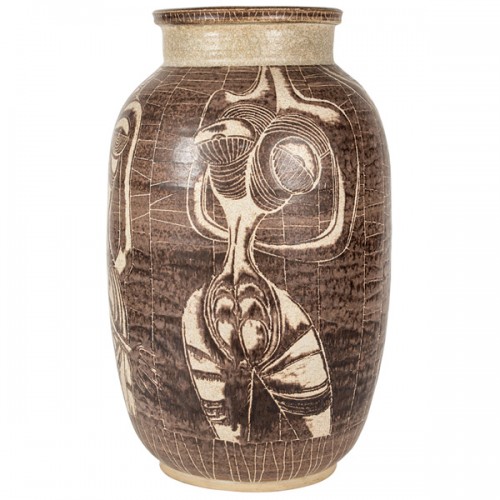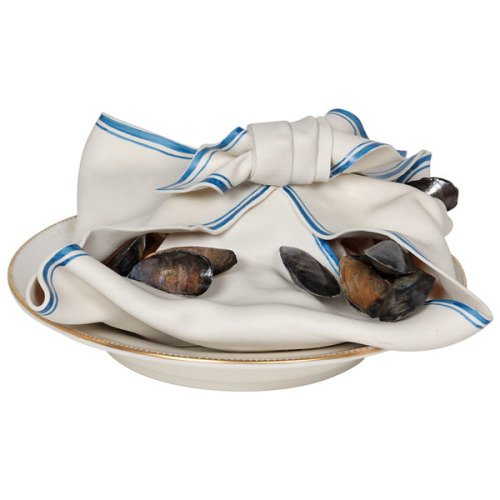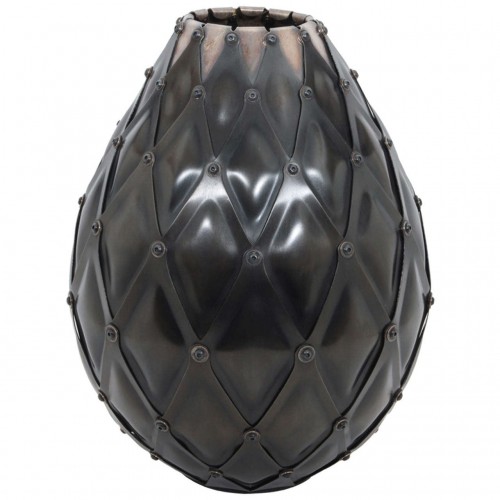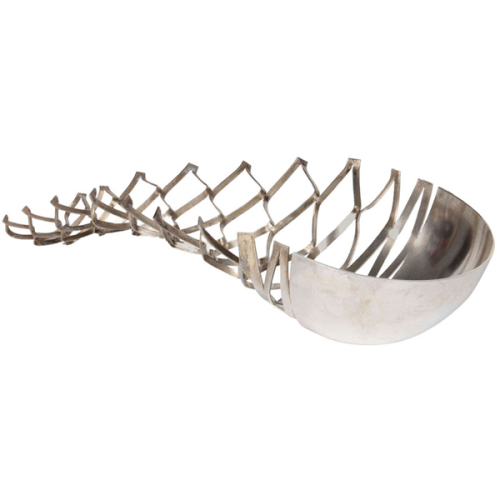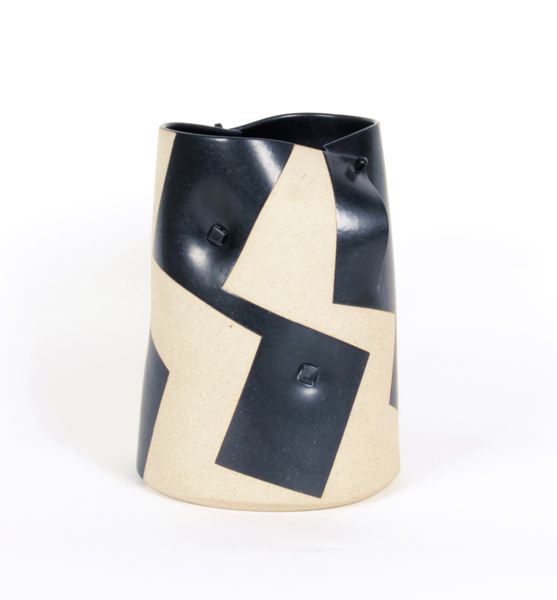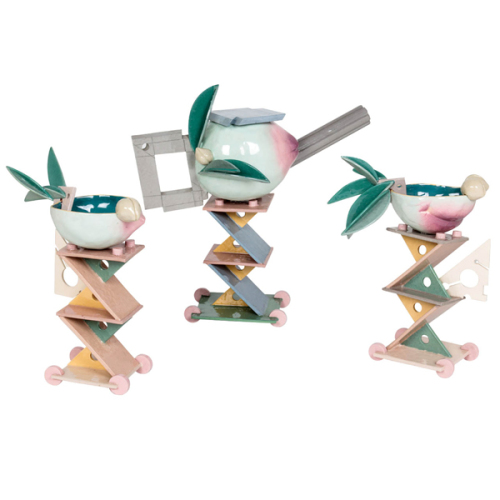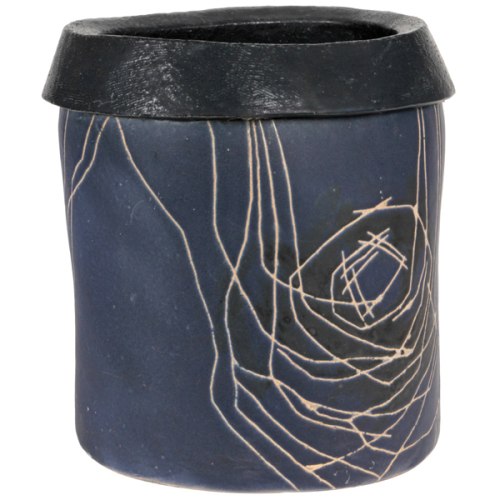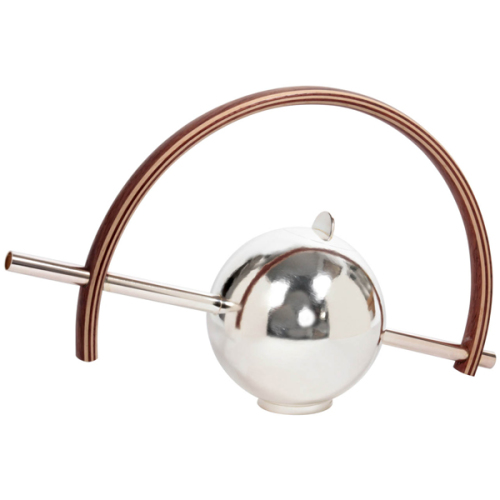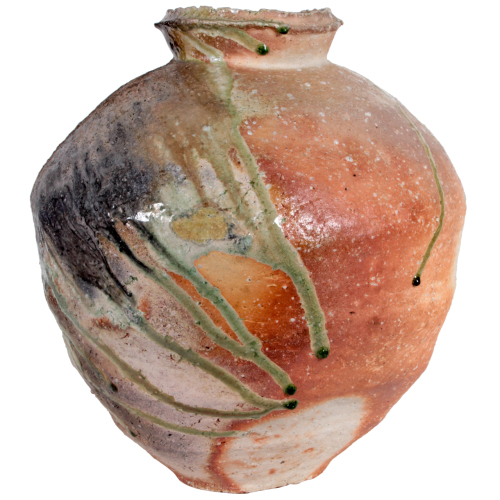HD 21 Decorative Arts

HD 21 Decorative Arts
-
Aaron Bohrod / F. Carlton Ball, Monumental, Hand Thrown Pottery Eve Vase 1952-56
AARON BOHROD (1907-1997) USA
F. CARLTON BALL (1911- 1992) USA“Eve” vase 1952-56
Monumental glazed stoneware vase with a brown and cream beige glaze with sgraffito decoration of four stylized nudes.
Signed: A. Bohrod F.C. Ball (inscribed)
Illustrated: Aaron Bohrod: Figure Sketches, Edwin E. Elliott and Howard E. Wooden (Dodge City, Kansas: Gall and Shaull, 1990) p. 17, fig. 32. A Decade of Still Life: Aaron Bohrod (Madison, Wis.: University of Wisconsin Press, 1966) p. 41.
H: 20 3/4 x Dia: 12 1/2″
Price: $29,000
***Aaron Bohrod himself considered this vase his most important work in ceramic. This exact vase is illustrated in “A Decade of Still Life: Aaron Bohrod” in a bisque state. There is a stable firing crack that is visible on the base (see photo) near the Bohrod signature which happened in the firing, but in no way affects the structure of the piece. A letter from Aaron Bohrod himself describing this piece and the history surrounding it also accompanies the vase.
For more information see: The Potter’s Art in California: 1885-1955, Hazel V. Bray (Oakland: Oakland Museum Art Department, 1980) pp. 56-57.
A painter of cityscapes, landscapes and trompe l’oeil paintings, Aaron Bohrod lived in Chicago from birth until 1948, when he moved to Madison, Wisconsin. There he was a member of the University of Wisconsin’s art faculty. Bohrod was a graduate of the School of the Art Institute of Chicago, and he also attended the Arts Students League in New York.
Aaron Bohrod was an American artist who was nationally known in his lifetime. He was the subject of frequent exhibitions and gallery shows in various locations, generally focusing on a particular chronological period of his artistic production. The recipient of numerous prizes and awards (including two Guggenheims and the purchase prize at the “Artists for Victory” exhibition of 1942-43 at the Metropolitan Museum in New York), he was both proficient and prolific as a painter, sculptor, printmaker, ceramicist and as an illustrator. In addition, he was the author of several books on art and an autobiography. Although he studied at the Art Institute of Chicago and the Art Students League in New York with a number of well-known and influential teachers, the one who exerted the most profound influence on him was John Sloan, who taught him to value both the Old Masters and the visual reality of the urban American scene. Bohrod returned to Chicago after studying with Sloan in New York “determined to do in my own way with my own city what Sloan had done with New York.” (Bohrod’s stylistic development has been typically characterized in terms of his early relationship to the gritty urban realism of the Ashcan School with which Sloan was associated and his later magic realism style with its virtuoso and meticulous technique and witty visual repartee, almost as if they were two separate and unrelated developments. Although his own description of the origins of his unique still life approach in his autobiographical book, A Decade of Still Life, may have guided critics to look at his oeuvre in this way, a closer assessment reveals clear connections between the earlier and alter periods. Before 1940, for example, he had created a prototype of the still lifes that were to become his hallmark. By the mid 1950s, he began to dedicate himself to the creation of paintings that are by turns resonant, mysterious, evocative and humorous. The studied and careful detail of the bricks on the buildings foreshadow the care that Bohrod will lavish on each of the carefully observed and realized objects in his later still lifes, while the anecdotal detail predicts the accumulation of objects on which his later work depends. The polished and masterful technique of this later work also suggests the Old Masters to whom he was introduced by Sloan.
F. Carlton Ball (1911-1992)
F. Carlton Ball was born in Sutter Creek, California, He studied art at Sacramento Junior College before enrolling at USC. He graduated from the University of Southern California in 1933. He later did graduate studies under Glen Lukens at USC. He taught at several colleges/universities, such as the CCAC (his first position in 1935), Mills College, University of Wisconsin at Madison, University of Southern Illinois at Carbondale, USC University of Puget Sound and etc. From our research, we believe his last teaching position was in Tacoma, Washington, at the Tacoma Community College. Primarily known for his throwing, he did combine his pots with the decorative artistry of his first wife Kathryn Uhl Ball and most importantly, the Wisconsin artist, Aaron Bohrod. He exhibited at the Association of San Francisco Potters, 1952 Los Angeles County Fair’s 6000 Years Art in Clay and the Crocker-Kingsley of Sacramento, California, to mention a few locations. Exhibited at the Nationals in 1941-1949, 1951-1960 and 1966. -
Didier Gardillou Trompe L’Oeil Porcelaine “Plat des moules et serviette” c. 2008
DIDIER GARDILLOU France
Trompe L’Oeil Porcelain “Plat des moules et serviette” c. 2008
High fired porcelain with a matte and shiny glaze, blue border detail on the napkin and realistically painted mussels.
Marks: DG (Didier Gardillou) monogram
H: 4 1/2″ x D: 10″ x W: 11″
Price: $5,450
Didier Gardillou is a master porcelain artist who creates Trompe L’Oeil masterpieces. He revived the antique craft of the porcelain florist. This technique and style first appeared in France in the 1740’s at the Manufactory of Vincennes, which in time would move and become known as the Royal Manufactory of Sèvres Porcelain.
-
Flavio Poli / Seguso Vetri d’Arte Murano Mid-Century Modern art glass vase c. 1950’s
FLAVIO POLI (1900-1984) Italy
SEGUSO VETRI D’ARTE ItalyVase c. 1950’s
Blue and clear Murano glass
H: 10″ x D: 3″ x W: 4 1/2″
Price: $1,850
Designer, businessman, ceramic artist. Born in Chioggia, he attended the Istituto d’Arte di Venezia and began work as a designer in ceramics. in 1929 he switched to glass and for Libero Vitali’s I.V.A.M. he designed animals, splendid Novecento-style nude figures in massiccio glass, as well as bowls and urns with figures resting on the inside, on lids or as handles. He subsequently collaborated with the Compagnia di Venezia e Murano, with the furnace of Mario and Lino Nason and with the engraver Gino Francesconi. in 1934 he accepted the artistic direction of Barovier, Seguso & Ferro, later to become Seguso Vetri d’Arte, and became partner three years later. Together with the master of the principal team Archimede Seguso, Poli was the author of grandiose lighting installations, of corroded vessels, of sculptures in bulicante glass, of animals in massiccio glass shaped while hot, productions which represented a milestone in the development of Murano glass. At the height of his artistic maturity, in the years between 1950 and 1960 he designed a series of sommerso glass pieces in a Nordic style, essential forms and sharp cold colors, which were awarded prestigious prizes (Compasso d’Oro). After leaving Seguso in 1963, between 1964 and 1966 he organized the artistic glass division at the Societˆ Veneziana di Conterie e Cristallerie.
-
Fontana Arte Italian, Mid-Century Glass “Fruit” Bookends, circa 1950
FONTANA ARTE Milan, Italy
“Glass fruit” bookends c. 1950
Glass, chromium-plated brass
For more information see: Fontana Arte, Una storia Trasparente, Laura Falconi (Milan: Skira, 1998).
H: 5” x W: 3 3/8” x D: 5”
Price: $3,500
-
Erik Tidäng Sculptural Artichoke Vase, 1999
ERIK TIDÄNG (b. 1973) Stockholm, Sweden
Sculptural “Artichoke” vase 1999
Oxidized and waxed iron, silver
Marks: ERIK, 2/2
H: 11 ½”
Price: $17,500
***The only other Artichoke vase (Number 1 out of 2) is in the permanent collection of the Swedish National Museum, Stockholm.
Erik Tidäng was born in Gothenburg, Sweden in 1973. He received his Bachelor and Master of Fine Arts from the Institution for Metaldesign, Konstfack.
-
Ane Christensen Contemporary British Sterling Silver Bowl 1999
ANE CHRISTENSEN (b.1972) born in Copenhagen, Denmark/ based in London, UK
Bowl 1999
Sterling silver
Marks: AKC, 925, Z, British hallmarks
H: 2 ½” x L: 12”
Price: $5,950
The starting point for all of metalworker Ane Christensen’s tableware is a single sheet of metal. Her aim is to develop a three dimensional object from a flat sheet without adding or removing any elements. Japanese paper packaging influences Ane’s work, but a more important influence is the half finished or half demolished structures of building sites that she says can hold unexpected sculptural qualities.
Ane graduated from the Royal College of Art and has since been involved in exhibitions in London, Denmark and Copenhagen, including more recently at Collect, V&A.
Ane makes pieces in a variety of metals including silver, stainless steel and powder coated copper.
-
Gustavo Perez, Mexican Contemporary Pottery, Ceramic vase 2000
GUSTAVO PEREZ Mexico
Stoneware vase 2000
Black, randomly positioned rectangles on a cream / sandy base with a pinned overlap detail
Signed: GP 2000-68
H: 9 1/4″ x D: 6 1/2″
Price: $5,500
Gustavo Pérez makes vessels that are simple, smooth and symmetrical. Their elegance is due to the precision of the incised lines and other markings on the pots. While using the same clay body—sand colored stoneware—throughout his work, the artist achieves a wide range of form and pattern and includes slowly undulating walls beneath the subtly incised surfaces.
Gustavo Pérez works are incessantly experimental. There have been parallel lines, calligraphic traces, geometric cuts into the surface, minimalist vessels, recollections of pre-Hispanic vases and references to other ancient cultures.
The ceramics of Gustavo Pérez are distinguished by eliminating superfluous details, by synthesis of his elements. During the past two decades he has created a visual language that seems closely aligned with music. Pure in form, with a significant structure, completely abstract and without specific associations, his language of line, the bending of forms, and the definition of the vessel mark his work as a distinctive voice. The form is not just a container or a receptacle; it is architecture.
-
Peter Shire Memphis Group California Art Pottery Rare Early “Peach Tea Set” 1980
PETER SHIRE (b. 1947) USA
Rare and early “California Peach” teaset 1980
Handmade earthenware with polychrome glazes
Made by Shire at his studio in Echo Park, CaliforniaSigned: Shire 1980 EXP (painted on base of each)
Model illustrated: Tempest in a Teapot, the Ceramic Art of Peter Shire, Norman M. Klein et al. (New York: Rizzoli, 1991) p. 11.
Teapot H: 10” x W: 11 1/4” x D: 5 1/2”
Pair of teacups H: 7 3/4” & 8”Price: $8,500
Peter Shire (born 1947) is a Los Angeles artist. Shire was born in the Echo Park district of Los Angeles, where he currently lives and works. His sculpture, furniture and ceramics have been exhibited in the United States, Italy, France, Japan and Poland; Shire has been associated with the Memphis Group of designers, has worked on the Design Team for the XXIII Olympiad with the American Institute of Architects, and has designed public sculptures in Los Angeles and other California cities. Shire has been honored by awards for his contribution to the cultural life of the City of Los Angeles.
-
Luke Lietzke, Large Glazed Hand Thrown Stoneware Floor Vase c.1955
LUKE LIETZKE (1906-2000), USA
LIETZKE DESIGNS Mogodore, OhioLarge floor vessel c. 1955-1960
Blue glazed stoneware cylindrical vessel which has been shaped at the top into an elliptical form; the black glazed lip is rolled over with a flaring collar-like edge and the body is decorated with an abstract incised sgraffito line decoration.
Signed on bottom: Lietzke (inscribed in oval)
H: 15″ x W: 14″ x D: 13″
Price: $17,500
Luke Lietzke studied art at Michigan State University and the Art Institute of Chicago. At Michigan State she met her husband and life-long partner in design, Rolland. They moved to Ohio when Rolland accepted a job with Goodyear Aerospace and in 1942, when Rolland took a job with Firestone, they moved to Akron, Ohio. It was there that Luke volunteered at the Akron Art Museum. This position quickly developed into a design curator’s position created especially for her. Her memorable exhibits included such notable artists as Charles Eames, George Nelson and Isamu Noguchi. In 1964 she left the Museum and for a short period worked as a design coordinator. In 1966, she and her husband created their own company where she functioned as an exhibition designer, an interior design consultant and most significantly: a designer craftsman. Her porcelain pieces consistently received exhibition awards since 1948 and are included in six museum collections. Her talents would often combine to develop special projects, such as the design for the Akron-Summit County Public Library. Both her pottery and jewelry reflect her wealth of knowledge as well as her exposure to the world of International art.
-
Salvatore Meli Important large scale Italian Sculpture / Ewer 1952
SALVATORE MELI (b. 1929) Italy
Important Sculpture / Ewer 1952
Glazed terra cotta, brown and dark green with white scraffito decoration, original stepped and angular wood base.
Signed: Meli 1952 Roma
For more info on Meli see: Design 1935-1965, What Modern was, ed. Martin Eidelberg (New York: Harry Abrams, 1991) p. 237.
Salvatore Meli belongs to that initial group of artists, including Guido Gambone and Lucio Fontana among others, who elevated Italian ceramics to a fine art during the post-war period. Meli conceived this vessel, first on paper, then by laboriously constructing the body in clay, coil by coil, to achieve the richly textured and dynamic form; the incised and painted decoration is in concert with the organic shape. The massive scale of this work defies function as a ewer but was created as a sculptural object. The original wooden base recalls Italian futurist sculpture forms of the early twentieth century.
H (with base): 23 1/2” x W: 13” x D: 9.5”
H (without base): 19 1/8”Price: $27,500
-
Wolfgang Gessl / Scandinavian Modern Sterling silver teapot with arching handle 1990
WOLFGANG GESSL (b. 1949) Austria / Sweden
Teapot 1990
Hand wrought and hand hammered spherical silver teapot with cylindrical handle and spout elements, maple and padouk wood layered arching handle
This is No. 2 out of the edition of 3 models.
Marks: Wolfgang Gessl (script impressed signature), 2/3, WO.GE (in a rectangle), Swedish assay mark for Stockholm, 925 (silver guarantee in a rectangle), E11 (in a rectangle), LF
Exhibited: Glänsande Geometri, Mettalum, Stockholm, Sweden
Illustrated: Gold and Silversmith Wolfgang Gessl: Exceeding Geometry, Kerstin Wickman, p. 16.
H: 10” x W: 16 ½” x D: 5 ½”
Price: $32,000
Wolfgang Gessl was born in 1949 in Vienna, Austria and trained as a goldsmith with Professor Hans Angerbauer. Upon moving to Sweden, Gessl studied under the eminent silversmith Sigurd Persson at Konstfack, the National University of Art, Craft and Design in Stockholm, Sweden.
Wolfgang Gessl has had fifteen solo exhibitions including shows at The National Museum, Stockholm and The Royal College of Art in London. His metalwork has been widely exhibited in Sweden, Europe and the U.S and his pieces can be found in many private collections throughout the world. He has taught at Konstfack for more than twenty-four years, and continues to live and work in Stockholm.
-
Kishimoto Kennin Japan Hand Thrown Monumental “Iga” Stoneware Vase, c. 1995
KISHIMOTO KENNIN (b. 1934), Japan.
Monumental “Iga” vase, circa 1995.
Hand thrown and handbuilt stoneware vase with a natural ash glaze in rich salmon rust, celadon, grey and black glaze
H: 20″ x Dia: 22″
Price: $20,000
1934 born in Nagoya 1953–1955 attends college in Nagoya 1960 moves to Mino, Gifu Prefecture 1965 establishes his own studio 1970 builds an anagama in Mikuni-Sanroku, where he lives and works until today 1976 appointed member of the Japan Crafts Association (Nihon kôgei-kai) Group exhibitions 1967 Asahi Ceramics Exhibition (Asahi tôgei-ten) 1968 Exhibition of Japanese Ceramics (Nihon tôgei-ten) 1970 International Exhibition of Chûnichi Ceramics (Chûnichi kokusai tôgei-ten) 1972–75 Japan Traditional Crafts Exhibition (Nihon dentô kôgei-ten)
One man shows:
1979 Takashimaya Gallery, Tôkyô; since then again in 1981, 1983, 1985, 1987, 1990.
1982 Hankyû Gallery, Ôsaka; since then again in 1983, 1984, 1985, 1986, 1987.
1984 Maru’ei Gallery, Nagoya; again in 1986.

